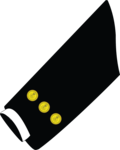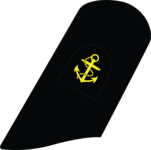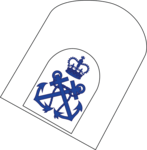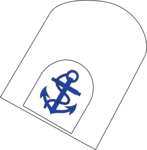Combined Cadet Force
The Combined Cadet Force (CCF) is a youth organisation in the United Kingdom, sponsored by the Ministry of Defence (MOD), which operates in schools, and normally includes Army, Royal Navy and Royal Air Force sections. Its aim is to "provide a disciplined organisation in a school so that pupils may develop powers of leadership by means of training to promote the qualities of responsibility, self reliance, resourcefulness, endurance and perseverance".
| Combined Cadet Force (CCF) | |
|---|---|
.jpg) Logo | |
| Founded | 1948 |
| Country | |
| Allegiance | HM The Queen |
| Type | Youth Organisation |
| Role | Leadership and discipline line education |
| Size | 42,720 Cadets[1] |
| Garrison/HQ | Regional Command Cadets Branch, Aldershot |
| Nickname(s) | 'The Corps' (within school environment) |
| Website | combinedcadetforce |
| Commanders | |
| Commandant Air Cadets (RAF CCF) | |
| President of Combined Cadet Force Association | |
| Vice President of Combined Cadet Force Association |
|
| Insignia | |
| Standard of the CCF |  |
| Ensign of the CCF |  |
| UK Military Cadet Forces military component of the youth organisations in the United Kingdom |
|---|
| Components |
| British Overseas Territories |
| Former Components |
| Personnel |
| Allegiance |
One of its objectives is "to encourage those who have an interest in the services to become Officers of the Regular or Reserve Forces", and a significant number of British military officers have had experience in the CCF.
Before 1948 cadet forces in schools existed as the junior division of the Officers' Training Corps framework, but in 1948 Combined Cadet Force was formed covering cadets affiliated to all three services. As of 2019 there were 42,720 cadets and 3,370 Adult Volunteers.[1] The MOD provides approximately £28M per year of funding to the CCF.[2]
History
The CCF was created in 1948[3] by the amalgamation of the Junior Training Corps (formerly the Junior Division of the Officers Training Corps) and the school contingents of the Sea Cadet Corps and Air Training Corps. CCFs are still occasionally referred to as "The Corps". On 12 May 1859, the Secretary of State for War, Jonathan Peel, sent out a circular letter to the public schools and universities inviting them to form units of the Volunteer Corps.[4] The first school cadet corps was established at Rossall School in February 1860,[5] initially as an army contingent only. Felsted already had an armed drill contingent at the time of the War Office letter under the command of Sgt. Major Rogers RM; its claim on these grounds to be the oldest school corps was upheld by Field Marshal Earl Roberts in a letter to the Headmaster of 1904.[6] In February 1861 the Oxford City Rifle Cadet Corps was founded, with five companies, the first of which was composed of pupils of the Linden House School, a private school in Headington,[7] and the second composed of pupils from Magdalen College School. In 1908, the units were re-titled the Officer Training Corps (OTC).[8] A school contingent may have any combination of Royal Navy, Army, Royal Air Force and sometimes Royal Marines sections, the army section is almost invariably the largest.
Independent and state schools
The CCF movement is dominated by the independent sector with 200 contingents still being based in independent schools with only around 60 in state schools.[9] It was reported in 2008 that some independent school CCF detachments would be opened to pupils of local state schools[10][9] One case of a fee-charging school allowing state school pupils to join the cadet force was Aldenham School in Watford, Hertfordshire linking its Cadet Force with the nearby state school Queen's to form a joint Cadet force.[11][12]
Unlike established CCFs, the MoD's model to expand cadet forces into schools require new schools with cadet units to either sponsor their own cadets or find a third party sponsor who can meet some of the cost to the MoD of funding and training Cadet Forces. Therefore, costs to schools involved are considerable, at over £200 per cadet per year and many thousands of pounds more for a cadet force to become an independent unit.[13]
Investigation into sexual abuse
In 2012 payouts made to victims of sexual abuse across all Cadet Forces, including the CCF, totaled £1,475,844. In 2013 payouts totaled £64,782, and in 2014 payouts totaled £544,213.[14]
Identity
CCF Contingents are part of the CCF, but are also part of their own school and as such are semi-autonomous organisations, run by internal school or school-related staff, supported by armed forces personnel. Army sections may wear their own capbadge, this might consist of the school or college logo or crest. However, Army headgear is worn with this capbadge. Royal Navy and Royal Air Force sections wear the appropriate RN/RAF other rank and officer capbadges.
Uniform
Royal Navy Section

They may be issued with combat uniform if required and some schools have No 1 uniform for senior cadets. Number 3 uniform is normally the parade uniform for the CCF (RN) and consists of a white Shirt, black tie, blue trousers,[15] and blue heavy wool jersey, worn with plain black shoes, a Brassard should be worn on the right arm, displaying qualification badges.[16][17][18] Number 4 uniform is the standard working uniform of the Royal Navy, in one form or another it has been in existence for over 60 years. This uniform is fire retardant and consists of a blue shirt, blue trousers, blue heavy wool jersey, beret, with CCF badge and black boots.[17]

Royal Marines Section
Royal Marines sections wear the bronzed Royal Marines badge with a red "tombstone" backing on a blue beret with MTP (Multi-Terrain Pattern) clothing, and either brown or black boots.[19] They may also wear a version of No.1 Ceremonial Uniform with Cadet insignia for special occasion.[20][18]
Army Section
Working uniform
The Army Section dress regulations are set out in Army Dress Regulations.[21] Army Section Cadets wear a Multi-terrain Pattern uniform for most occasions.[15] A contingent badge may be worn on the left blanking plate underneath the Union Flag. All cadets wear a rank slide with the word "CADET" in embroidered red capital letters at the top, any rank is then shown underneath in black. Cadets may be given permission to wear a stable belt of CCF, school, or affiliated unit pattern.[22]

Ceremonial uniform
No. 2 Dress/Future Army Dress (FAD) may be worn for ceremonial or other relevant uses (such as drill or duty cadets) and is to be worn in accordance with the dress regulations mentioned above.
Royal Air Force Section
RAF cadets wear a version of the No.2 dress. This consists of either light blue shirt and tie or a dark "working" blue shirt, blue-grey trousers (male cadets) or skirt/slacks (female cadets), a blue-grey jumper: V-neck or round neck version, and an RAF blue beret with the RAF cap badge.[16][23][24] They also wear a brassard to distinguish themselves as cadets.[23] Except for the cap badge, this is identical to the uniform of the ATC and regulations for its wear can be found in AP1358C.[23][24][15] Most RAF sections issue cadets with combat clothing, formally the CS95 DPM standard, but now are issued with Multi-terrain pattern uniform (MTP).[19]
Cadets


The MOD Sponsored Cadet Forces Statistics are published annually.[1] Statistics are provided for the Community Cadets (the Sea Cadet Corps and Volunteer Cadet Corps (VCC), Army Cadet Force (ACF) and Air Training Corps (ATC)) and the Combined Cadet Force. The Volunteer Cadet Corps (VCC) is included in these statistics for the first time, as its status changed to become the fifth MOD sponsored cadet force in 2017.[25]
| Section | Cadets |
|---|---|
| Army | 28,390 |
| Royal Air Force | 8,160 |
| RN/RM | 6,170 |
| Total | 42,720 |
In October 2007 the under-secretary of state for defence gave details of the total number of CCF sections, and the number present in state schools.[26] As of 2012 under the Cadet Expansion Programme (CEP) 100 new CCF Units were created in State Schools.[27]
| Section | No. of sections | No. in state schools |
|---|---|---|
| Army | 359 | 161 |
| Royal Air Force | 199 | 41 |
| Royal Navy | 110 | 12 |
| Royal Marines | 18 | 1 |
| Total | 686 | 215 |
Cadet ranks
Most Cadet ranks are standard non-commissioned ranks, prefixed by "Cadet", for day-to-day administration the "Cadet" prefix is often omitted. The highest rank depends on the size of the contingent, but are usually Cadet Regimental Sergeant Major, (Army and RM Sections) and Cadet Warrant Officer (RN and RAF Sections). Some contingents may have Junior (and sometimes Senior) Under Officers. Cadet Under Officers' rank badges are blue bands 12 mm wide across each shoulder slide, with the addition of the letters CCF underneath..
The "Cadet" prefix is omitted from all ranks during the day-to-day running of activities. Cadet Warrant Officers are to be addressed as "Warrant Officer" and all other cadets by their rank, "Flight Sergeant", "Sergeant" or "Corporal", as the case may be. In some contingents, it is a tradition for cadets to refer to Cadet Warrant Officers and Cadet Company or Regimental Sergeant Majors as "Sir or Ma'am".
Cadets are promoted on their level of experience and their level of commitment to the cadet force. Also cadets are promoted on excellent or merit. Senior cadet's duty is to help the running of parades etc and to help their Contingent Commander or another officer of their contingent.
The Naval Cadet that is in command of the naval section can also be called Coxswain.
| UK Cadets |
Officers | Cadet Senior NCOs | Cadet Junior NCOs | Cadets | Recruits | |||||||
|---|---|---|---|---|---|---|---|---|---|---|---|---|
| CDT 8 | CDT 7 | CDT 6 | CDT 5 | CDT 4 | CDT 3 | CDT 2 | CDT 1 | CDT (R) | ||||
 CCF Navy Cadets (Edit) |
 |
 |
 |
 |
 |
 |
 |
 |
 | |||
 |
 |
 |
 |
 |
 |
 |
 |
 | ||||
 |
 |
 |
 |
 |
 |
 |
 |
 |
 | |||
| Under Officer | Warrant Officer Cadet |
Chief Petty Officer Cadet |
Petty Officer Cadet |
Leading Cadet |
Able 3* Cadet |
Able 2* Cadet | Able 1* Cadet | Naval Cadet |
New Naval Entry | |||
| UO | WOCDT | CPOCDT | POCDT | LCDT | A3*CDT | A2*CDT | A1*CDT | NCDT | NNE | |||
| UK Cadets |
Officers | Cadet Senior NCOs | Cadet Junior NCOs | Cadets | Recruits | |||||||
| CDT 8 | CDT 7 | CDT 6 | CDT 5 | CDT 4 | CDT 3 | CDT 2 | CDT 1 | CDT (R) | ||||
 CCF Royal Marines Cadets (Part of the CCF RN) (Edit) |
 |
 |
 |
 |
 |
 |
 |
 |
No insignia | |||
| Under Officer | Cadet Warrant Officer First Class |
Cadet Warrant Officer Second Class |
Cadet Colour Sergeant |
Cadet Sergeant |
Cadet Corporal |
Cadet Lance Corporal |
Cadet | Recruit | ||||
| UO | CDTWO1 | CDTWO2 | CDTCSGT | CDTSGT | CDTCPL | CDTLCPL | CDT | RCT | ||||
| UK Cadets |
Officers | Cadet Senior NCOs | Cadet Junior NCOs | Cadets | Recruits | |||||||
| CDT 8 | CDT 7 | CDT 6 | CDT 5 | CDT 4 | CDT 3 | CDT 2 | CDT 1 | CDT (R) | ||||
 CCF Army Cadets (Edit) |
 |
 |
 |
 |
 |
 |
 |
 |
 |
No insignia | ||
| Under Officer | Cadet Regimental Sergeant Major |
Cadet Regimental Quartermaster Sergeant |
Cadet Company Sergeant Major |
Cadet Staff Sergeant |
Cadet Sergeant |
Cadet Corporal |
Cadet Lance Corporal |
Cadet | Recruit | |||
| UO | CDTRSM | CDTRQMS | CDTCSM | CDTSSGT | CDTSGT | CDTCPL | CDTLCPL | CDT | RCT | |||
| UK Cadets |
Officers | Cadet Senior NCOs | Cadet Junior NCOs | Cadets | Recruits | |||||||
| CDT 8 | CDT 7 | CDT 6 | CDT 5 | CDT 4 | CDT 3 | CDT 2 | CDT 1 | CDT (R) | ||||
 CCF RAF Cadets (Edit) |
No equivalent |  |
No equivalent |  |
 |
 |
 |
No insignia | No equivalent | |||
| Cadet Warrant Officer |
Cadet Flight Sergeant |
Cadet Sergeant |
Cadet Corporal |
Cadet Lance Corporal |
Cadet | |||||||
| CWO | Cdt FS | Cdt Sgt | Cdt Cpl | Cdt LCpl | Cdt | |||||||
Army cadets ranks share associated regiment's equivalent rank title (e.g. Corporal in the Royal Artillery becomes Bombardier.)
The CCF is separate from the Community Cadet Forces namely the Sea Cadet Corps, the Army Cadet Force and the Air Training Corps, and the other MOD recognized cadet force Volunteer Cadet Corps. Pupils normally join at the age of 13 or 14 (Year 9), with both sexes able to take part.
Cadet Force adult volunteers (CFAV)
Cadet Force Adult Volunteers (CFAVs), who are the uniformed civilian staff that work in the school contingents and provide training to the cadets. Unlike the other cadet organisations (ATC/SCC/ACF), most adult volunteers are commissioned officers, the exception often being the School Staff Instructor (see below) and the newer position of Sergeant Instructor (SI).
CCF Officers
CCF officers are not members of the armed forces and are usually teachers or other school staff, as such they are not subject to military law, but are subject to CCF Regulations[28] they are subordinate to officers in the Armed Forces whether Regular or Reserve.[28] Until 2017 CCF (Army) and CCF (RAF) officers were in special categories of the reserves of their service whereas CCF (RN) Officers were 'appointed' and did not hold commissions. However, on 1 December 2017, the Cadet Forces Commission was introduced and since then this type of commission has been held by all CCF officers[29]
Training
- Officers in the Naval section of the CCF, undertake the six day CCF Royal Navy officer induction course training at Britannia Royal Naval College, Dartmouth. It is commanded by a course officer (regular Naval Service) and at least two CFAVs to assist. The training is delivered by regular sailors.[30]
- Unlike officers in the Army Cadet Force, CCF (Army) officers do not attend the Cadet Forces Commissions Board of the Army Officer Selection Board and are commissioned based on recommendation from the Headmaster of the employing school and confirmed by the relevant Army Brigade. Prospective officers may be appointed as an "Adult Under Officer", awaiting commissioning.[21]
- CCF (RAF) officers attend the Officer and Aircrew Selection Centre and undertake the five day RAF Air Cadets Officers' Initial Course at RAF College Cranwell, as officer cadets. Upon successful completion of the course, they are commissioned as RAF CCF Officers.[31] Formally, they were known as Royal Air Force Volunteer Reserve Training branch (RAF VR (T)) officers. However, recently all RAF cadet organisation staff have been re-syled/branded as being part of the one umbrella "RAF Air Cadets" organisation. Their rank slides are thus emblazoned with the legend 'RAF Air Cadets'.[32]
All CCF adult induction/basic/initial courses cover the basic skills needed for CFAVs who wish to serve in the CCF, such as drill and turnout, leadership and teamwork tasks, weapon training, navigation, etc.
School Staff Instructors (SSI)
Supporting officers in the running of the Contingent is the School Staff Instructor (SSI) - usually a retired Senior Non-commissioned Officer (SNCO) or Warrant Officer. Although they are civilians, they retain their rank as a courtesy and are employed by the school to instruct and assist in the running of the Contingent.[33] Whilst the majority of the SSIs are SNCOs it is also possible for them to be a commissioned officer. There is usually only one SSI per Contingent and they are also supported by other external staff, including the RN's Area Instructors, various Brigade Cadet Training Teams (CTTs) and RAF TEST SNCOs.
Civilian Instructors (CI)
Like the community cadet forces, some Contingents may have one or more Civilian Instructors (CI). These are adult volunteers who may instruct in either a specialist (first aid, signals, etc.) or more generalised role when the establishment level of officers does not include sufficient suitably qualified and experienced personnel to teach these subjects. They receive no pay for time spent with cadets but may claim reimbursement for expenses at the Contingent Commander's discretion. Many are members of the academic or support staff at the school.[34]
Adult Non-commissioned Officers (NCO)
In 2018 the role of "Sergeant Instructor" (SI) was introduced for CCF (Army) sections, this is the first occasion that adults other than SSIs have been appointed as an NCO rather than a commissioned rank in the CCF.[34] Similarly to the ACF the role of the SI is to support the CCF officers. Whilst not holding a commission. SIs are uniformed, paid for their activities, have to undertake vetting/background checks and the CCF Basic Course at Cadet Training Centre Frimley Park.
| RN (CCF) RNR | Army (Cadet Forces) | RAF (RAFAC) | ||||
|---|---|---|---|---|---|---|
| Chief Petty Officer
(School Staff Instructor) |
CPO |  |
Regimental Sergeant Major Instructor | RSMI |  |
No equivalent |
| Regimental Quartermaster Sergeant Instructor | RQMSI |  | ||||
| Company Sergeant Major Instructor | CSMI |  | ||||
| Sergeant Instructor | SI |  | ||||
Officer ranks
CCF (RN) ranks are the same as for RN (and RNR) officers with the suffix '(CCF) RNR', but their rank braid is 'wavy' as used in the past by the RNVR.
CCF (Army) officers wear a "CCF" legend on their rank slides in addition to any insignia of affiliated Army regiment or Corps.
CCF (RAF) Officers wear 'RAF Air Cadets' on their rank sides.
Since the introduction of the Cadet Forces Commission, ranks do not indicate membership of the British Armed Forces. Instructors joining the Army section are initially appointed as "Adult Under Officer" whilst awaiting commissioning.[35]
| RN ((CCF) RNR) | Army (Cadet Forces) | RAF (RAFAC) | |||
|---|---|---|---|---|---|
| Commander (CCF) RNR |  |
Lieutenant Colonel |  |
Wing Commander |  |
| Lieutenant Commander (CCF) RNR |  |
Major |  |
Squadron Leader |  |
| Lieutenant (CCF) RNR |  |
Captain |  |
Flight Lieutenant |  |
| Sub Lieutenant (CCF) RNR |  |
Lieutenant |  |
Flying Officer |  |
| Second Lieutenant |  |
Pilot Officer |  | ||
| Adult Under Officer |  |
Officer Cadet |  | ||
Cadet Training
The different sections have different syllabuses with a degree of overlap. All the sections learn drill and all cadets are trained to fire the L98A2 5.56 mm Cadet General Purpose rifle, a semi-automatic only version of the L85A2 used by the UK armed forces. There are also opportunities to fire the L144 A1 Cadet Small Bore Target Rifle (CSBTR) and the L81 Cadet Target Rifle.
Royal Navy section
Cadets in the Royal Navy section receive instruction in boat-work and other naval subjects (including flying with the Fleet Air Arm). The Royal Navy also offers many CCF courses during the school holidays which are open to any members of any CCF.
| CCF RN Ships | ||||
|---|---|---|---|---|
| Name | Type | Class | Length (ft) | |
| MV Blue Swan | Motor Boat | Talisman | 49 | |
| MV Black Swan | Motor Boat | Talisman | 49 | |
| MSY Cornish Air | Sloop | Rustler | 36 | |
| STC Amaryllis | Sloop | |||
| TS Dragon | Sloop | |||
| TS Phoenix | Sloop | |||
Royal Marine Section
The Royal Marines section, although a part of the Navy, tend to train independently, covering battle drills, weapons handling and marksmanship, fieldcraft, camouflage and concealment and the history of the Royal Marines.
Army section
The Army section follows the Army Proficiency Certificate (APC) subjects such as drill and turnout, skill at arms, shooting, map and compass, fieldcraft and first aid.[36]
Royal Air Force section
As CCF (RAF) sections form part of the larger Royal Air Force Air Cadets, they are eligible to undertake the same syllabus and training opportunities as the Air Training Corps:
RAF section cadets are given the opportunity to fly in both powered aircraft, most notably the Grob Tutor and in unpowered gliders such as the Grob Viking; their training and flying courses are identical to those available to members of the Air Training Corps. As well as that the Cadets can also be involved in a multitude of battle training and tactics as well as opportunities to fly in various aircraft from the RAF and allied nations. The section also will learn about aerospace management, the structure of aircraft and propulsion, engineering, air power as well as an opportunity to see how most RAF stations, sections and wings or squadrons operate. As well as practical learning, RAF cadets also follow an academic syllabus. Cadets are usually taught "Part 1" before being expected to complete Parts 2 - 4 by themselves through the medium of Ultilearn. Completing Part 4, also known as the Master Cadet Award, leads to a BTEC Level 2 in Aviation Studies being awarded.
Further training
All sections can undertake leadership courses at Frimley Park, Nesscliffe, or RAF Cranwell, as well as adventurous training. There are also other courses available for cadets to enhance their skills, such as Junior and Senior Cadet Instructor Courses (JCIC, SCIC) and Method of Instruction (MOI).
See also
Elements of the Community Cadet Forces
- Sea Cadet Corps
- Army Cadet Force
- Air Training Corps
Other MoD sponsored or recognized cadet forces
Related articles
References
- https://assets.publishing.service.gov.uk/government/uploads/system/uploads/attachment_data/file/804484/MOD_Sponsored_Cadet_Forces_Statistics_April_2019.pdf
- Letter Assistant Head Youth and Cadets, Reserves Forces and Cadets, D/DRFC/4/1/5, 8 August 2014
- The History of the Combined Cadet Force Archived 29 November 2014 at the Wayback Machine, 1260sqn.co.uk
- 'History of Felsted School (1564–1947)' by Michael Craze
- "Combined Cadet Force (CCF)". Rossall School. Retrieved 12 April 2009.
It has, however, been established that Rossall was the first public school to enrol Volunteers and have them sworn in under the provisions of the Volunteer Act, and we have the original muster book in which the first names were entered on 1st February, 1860. Other Corps at Eton, Felsted, etc., were raised within a month or two.
- 'History of Felsted School 1564-1947', Michael Craze
- Giles Hudson, "Shots of Shots: Photographs of the Oxford Volunteer Rifle Corps", Matters Photographical (1 Dec 2012)
- Air Cadets - History, raf.mod.uk
- Henry, Julie (8 January 2012). "Military cadet forces in every school, says schools commissioner". The Daily Telegraph.
- Garner, Richard (20 September 2008). "Private schools will let state pupils join cadet forces". The Independent. Retrieved 30 April 2010.
A ground-breaking agreement to allow state school pupils to join cadet forces in some of Britain's most elite private schools is to be announced this month. Six of the country's top fee-paying schools – including City of London boys' school and Highgate – have agreed to open up their Combined Cadet Forces to neighbouring state schools.
- "CCF Biennial Inspection". Retrieved 24 September 2019.
- Farmer, Steven Swinford and Ben (14 February 2014). "Public school funding for military cadet forces diverted to state sector". Retrieved 24 September 2019 – via www.telegraph.co.uk.
- "200 invalid-request". www.whsb.essex.sch.uk. Archived from the original on 23 April 2018. Retrieved 24 September 2019.
- Quinn, Ben (28 December 2014). "Ministry of Defence pays out £2m to settle cadets' sexual abuse claims". Guardian. Retrieved 22 January 2018.
- "Pupils on parade - CCF Inspection 2016". 2017. Retrieved 15 February 2019.
- "CCF Uniform". Retrieved 12 February 2019.
- "Royal Navy Uniform" (PDF). CCF Connected. Retrieved 15 February 2019.
- "Sea Cadet Uniform Regulations". Retrieved 15 February 2019.
- "Field Uniform" (PDF). CCF Connected. Retrieved 15 February 2019.
- "Royal Marines CCF section launch, May 2017" (PDF). Dame Allens. May 2017. Retrieved 15 February 2019.
- "ARMY DRESS REGULATIONS (ALL RANKS) : Part 8 : Dress Regulations for Combined Cadet Force (Army Sections) and the Army Cadet Force" (PDF). Legacy.armycadets.com. April 2015. Archived from the original (PDF) on 3 December 2018. Retrieved 1 February 2019.
- "Dress Regulations for Combined Cadet Force (Army Sections) and the Army Cadet Force" (PDF). Retrieved 12 February 2019.
- "Uniform Dress and Appearance Regulations for the Air Cadet Organization (AP1358C)" (PDF). January 2017. Retrieved 12 February 2019.
- "RAF Uniform" (PDF). CCF Connected. Retrieved 15 February 2019.
- "MOD Sponsored Cadet Forces Statistics" (PDF). Assets.publishing.service.gov.uk. 1 April 2018. Retrieved 1 February 2019.
- "Parliamentary written questions". Hansard. 29 October 2007. Retrieved 13 March 2008.
- "CCF CEP Press Release". Combinedcadetforce.org.uk. Retrieved 11 March 2016.
- "Cadet Forces Commission Transfer Boards - a Freedom of Information request to Ministry of Defence". WhatDoTheyKnow. 4 December 2017. Retrieved 24 September 2019.
- "HM the Queen approves new commission for cadet…". Combined Cadet Force. 1 February 2019. Retrieved 1 February 2019.
- "Connected - Spring 2018". Issuu.com. Retrieved 1 February 2019.
- "Connected Summer 2018". Issuu.com. Retrieved 1 February 2019.
- "CFC Explained". Air Cadet 101. Retrieved 5 October 2018.
- "Uniform regulations for officers and instructors". Ams.mod.uk. Archived from the original (DOC) on 10 June 2007. Retrieved 11 September 2007.
- Putty, Electric (24 September 2019). "Roles & Ranks". Combined Cadet Force. Retrieved 24 September 2019.
- "Army dress regulations 2017 - a Freedom of Information request to Ministry of Defence". WhatDoTheyKnow. 8 March 2017. Retrieved 24 September 2019.
- Putty, Electric (24 September 2019). "The Army". Combined Cadet Force. Retrieved 24 September 2019.
External links
| Wikimedia Commons has media related to Combined Cadet Force. |
- CCF website
- Combined Cadet Force official website (combinedcadetforce.org.uk)
- Army Dress Regulations Part 8 (Cadets) (2013)
